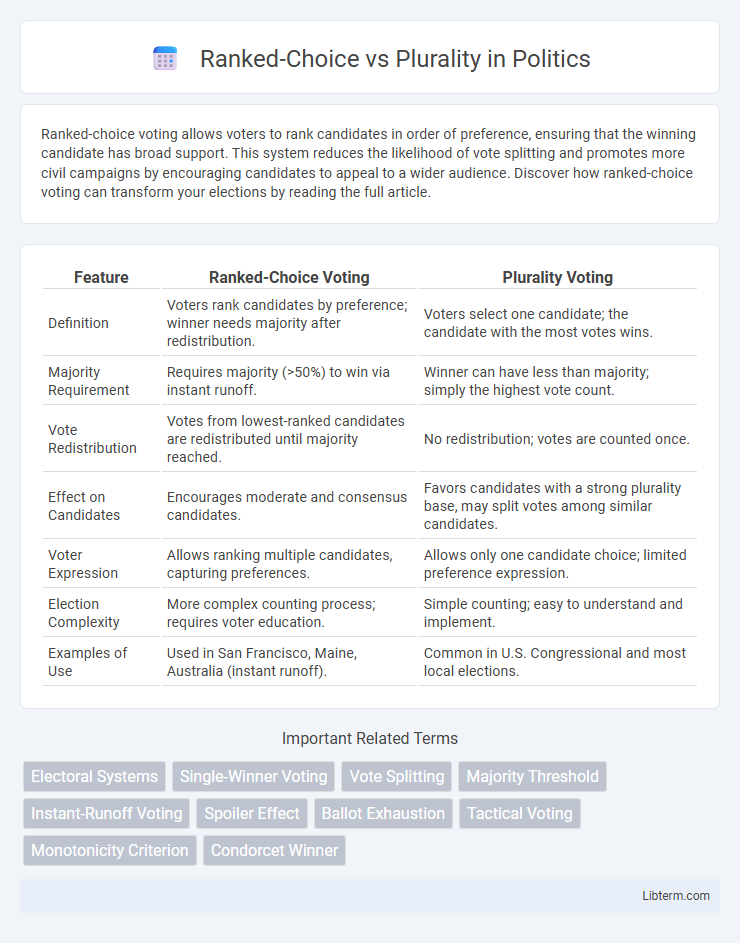Ranked-choice voting allows voters to rank candidates in order of preference, ensuring that the winning candidate has broad support. This system reduces the likelihood of vote splitting and promotes more civil campaigns by encouraging candidates to appeal to a wider audience. Discover how ranked-choice voting can transform your elections by reading the full article.
Table of Comparison
| Feature | Ranked-Choice Voting | Plurality Voting |
|---|---|---|
| Definition | Voters rank candidates by preference; winner needs majority after redistribution. | Voters select one candidate; the candidate with the most votes wins. |
| Majority Requirement | Requires majority (>50%) to win via instant runoff. | Winner can have less than majority; simply the highest vote count. |
| Vote Redistribution | Votes from lowest-ranked candidates are redistributed until majority reached. | No redistribution; votes are counted once. |
| Effect on Candidates | Encourages moderate and consensus candidates. | Favors candidates with a strong plurality base, may split votes among similar candidates. |
| Voter Expression | Allows ranking multiple candidates, capturing preferences. | Allows only one candidate choice; limited preference expression. |
| Election Complexity | More complex counting process; requires voter education. | Simple counting; easy to understand and implement. |
| Examples of Use | Used in San Francisco, Maine, Australia (instant runoff). | Common in U.S. Congressional and most local elections. |
Introduction to Voting Systems
Ranked-choice voting allows voters to rank candidates by preference, promoting majority support and reducing vote splitting, while plurality voting awards victory to the candidate with the most votes, even without majority backing. Ranked-choice systems encourage more nuanced voter expression and can lead to more representative outcomes, unlike plurality systems that often result in strategic voting and the spoiler effect. Understanding these fundamental differences is crucial for evaluating electoral fairness and voter engagement in democratic processes.
What is Ranked-Choice Voting?
Ranked-choice voting is an electoral system allowing voters to rank candidates by preference, promoting majority support by redistributing votes from eliminated candidates until one surpasses 50%. This method contrasts with plurality voting, where the candidate with the most votes wins regardless of majority. Ranked-choice voting enhances voter expression and reduces the spoiler effect, contributing to more representative election outcomes.
What is Plurality Voting?
Plurality voting, also known as "first-past-the-post," is a voting system where the candidate with the most votes wins, regardless of whether they secure an absolute majority. This method is widely used in countries like the United States and the United Kingdom for elections at various governmental levels. Plurality voting tends to favor a two-party system and can result in winners who do not represent the preference of the majority of voters.
Key Differences Between Ranked-Choice and Plurality
Ranked-choice voting allows voters to rank candidates by preference, ensuring the winner has majority support through instant runoffs, while plurality voting selects the candidate with the most votes, even without a majority. Plurality systems often result in "spoiler" effects, where vote splitting among similar candidates can cause less popular candidates to win, a problem minimized by ranked-choice voting. Ranked-choice voting encourages more diverse candidate participation and reduces negative campaigning by promoting consensus choices over simple vote counts.
Benefits of Ranked-Choice Voting
Ranked-choice voting enhances electoral outcomes by allowing voters to rank candidates in order of preference, reducing the impact of vote splitting and the spoiler effect common in plurality systems. This method ensures that the winning candidate secures a majority support, promoting broader consensus and legitimacy. It encourages more diverse candidates to run, improving voter engagement and satisfaction.
Drawbacks of Ranked-Choice Voting
Ranked-choice voting can lead to voter confusion due to its complexity compared to the straightforward plurality system, potentially decreasing voter turnout. Counting votes in ranked-choice elections requires multiple rounds and can delay results, increasing administrative costs and logistical challenges. Additionally, ranked-choice voting may not eliminate strategic voting entirely, and in some cases, can produce non-monotonic outcomes where ranking a preferred candidate higher could paradoxically harm their chances of winning.
Advantages of Plurality Voting
Plurality voting offers simplicity and ease of understanding, making it accessible to a broad electorate without requiring complex ranking decisions. Its straightforward "first-past-the-post" approach typically results in faster vote counting and quicker election outcomes. This system often favors stable two-party systems, reducing the likelihood of fragmented legislatures and promoting clear majority governance.
Disadvantages of Plurality Voting
Plurality voting often results in the "spoiler effect," where a candidate wins without majority support due to vote splitting among similar candidates, undermining true voter preference representation. This system discourages political diversity by favoring two dominant parties, limiting choices for voters and stifling minority voices. Furthermore, plurality voting can lead to strategic voting, where voters select less preferred but more viable candidates to avoid "wasting" their votes, distorting authentic election outcomes.
Impact on Election Outcomes
Ranked-choice voting (RCV) reduces the spoiler effect by allowing voters to rank candidates in order of preference, leading to more representative outcomes and often electing consensus winners. Plurality voting can result in vote splitting among similar candidates, causing winners to secure office without majority support, which may misrepresent voter intent. Empirical studies show RCV increases voter satisfaction and diversity among elected officials compared to plurality systems.
Which System is Better for Democracy?
Ranked-choice voting enhances democratic representation by allowing voters to rank candidates in order of preference, reducing the spoiler effect and encouraging majority support. Plurality systems often result in a "winner-takes-all" outcome that can marginalize minority voices and lead to strategic voting rather than true preference expression. Studies show ranked-choice voting fosters more inclusive elections and higher voter satisfaction, making it a better fit for democratic principles.
Ranked-Choice Infographic

 libterm.com
libterm.com